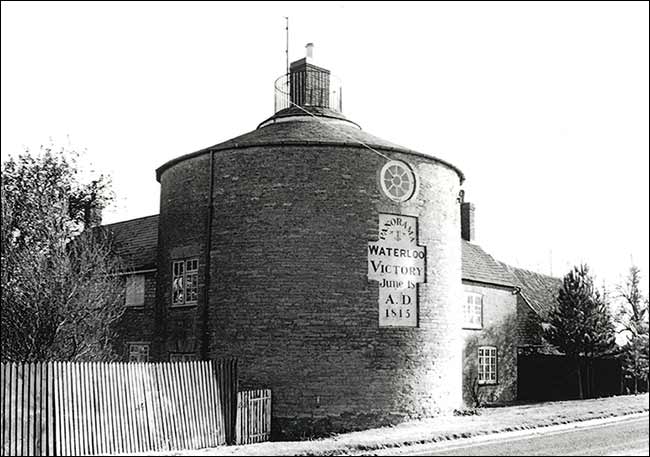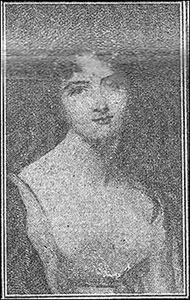| Special newspaper article from the Evening Telegraph dated 1 December 1927 |
|||||||
|
|||||||
 |
|||||||
|
Discussing local folk lore and interesting buildings in this part of the county with a veteran who has spent the whole of his life – about half-way between eighty and ninety years – in this district, a special commissioner gained a deal of information regarding the structure about which very little has been previously published, but which possesses some remarkably interesting associations, in addition to having passed through many changes and vicissitudes during the one hundred years it must have stood like a sentinel on the main road leading from Huntingdon to Northampton This structure is “Burton Latimer Round House,” and from the particulars related, this building must possess direct associations with the Duke of Wellington, the hero of The story, or history, is best given as the veteran related it to me. Many of the incidents mentioned having been followed up and amplified by a search through the historical archives of the “Evening Telegraph.” “Burton Round House,” he commenced, “ is possibly one of the most unique buildings in the country. The house itself stands in the parish of Burton Latimer, but the 120 to 130 acres of land with it are in three other parishes. In fact, if you climb over one fence in the farm yard, you set your feet in the parish of Great Addington; over another fence you land into the parish of Woodford; and some of the land is in the parish of Finedon. RATE DEMANDS FROM FOUR PARISHES “Many people grumble about receiving their rate demand notes, but I don’t know what they would do if they lived at Burton Round House; for rate demands come in from four parishes. “And talk about election literature! Well the residents must simply get inundated with the house and farm in three different constituencies – Kettering (through being in Burton Latimer), Wellingborough (Finedon), and “But it’s about the Duke of Wellington you want to know. Well, I think there is no doubt about it, for the front of the building bears the inscription: - ‘Panorama – Waterloo Victory, June 18th. A.D.1815.’ “There’s no need for me to tell you that panorama means a complete view; a picture of a landscape all round, as seen from one point; or a picture of several scenes unrolled before the spectators. When I was a young man there were panorama travelling shows which used to exhibit on a screen a kind of moving pictures, but nothing like the present day cinematographs. Some people named “The words on the side of the building – ‘Waterloo Victory, June 18th, A.D.1815’ – easily explain themselves. The building was erected in commemoration of that victory. But people naturally wonder why such a building should be erected in such an outlandish place for such a purpose. It is two miles from Finedon, two miles from Addington, two miles from Burton Latimer, two miles from THE ARBUTHNOTTS
“Well, at that time, so I have been told by my father and mother, and in fact, by others, there lived at Woodford House a General Arbuthnott, who was descended from an ancient Scottish family, and was a friend of the Duke of Wellington. The Duke used to visit him quite frequently, and acted as godfather to his daughter, Marcia, to whom he once gave some cream ponies. “My parents have also told me that when the Duke visited Woodford House he would accompany General Arbuthnott and the family to the services at one of the churches at “At Woodford House there was a special bedroom set apart and known as the Duke’s bedroom. I don’t know whether it is still regarded as such today, but maybe it is. “That reminds me that the corner of the road leading to Thrapston and to Finedon from “Now you will want to know how it was the Round House came to be erected as a victory memorial. From my own knowledge naturally I cannot tell you, but you can take it for granted that my information is about correct. PANORAMA OF “When the Duke was paying a visit to Woodford House, and saw the district, he found that from the spot where the Round House now stands, his eyes met a scene that reminded him of the fields of At this juncture it would perhaps be appropriate to drop in a few records which go to bear out the statement of my veteran friend. When a portion of the Woodford Estate was submitted to public auction in June 1922, at the Royal Hotel, Kettering, by Messrs Berry Bros and Bagshaw, by order of the owner, Mr W M Plevins, of Woodford House, the catalogue, which included the Round House, described it as “A house formerly an old-time wayside inn, bearing the inscription, ‘Panorama –Waterloo Victory, June 18,A.D. 1815.’ In commemoration of the visit of the Duke of Wellington, who frequently stayed at Woodford House, when he remarked that the view from the top of the house reminded him of the field of At the sale it was purchased by the tenant, Mrs. Corney, who, with her family, is the present resident. There is a ground floor, first floor, and top floor. The latter is one round room, and contains steps leading to the turret from which a splendid view of the surrounding country can be obtained. SOME MERRY PARTIES “Now for a few comments upon the later history of the old Round House,” commented my friend. “If it could only write its own story it would be a remarkably long and interesting one. It was a wayside inn when I remember it first. It was kept by a man named T. Hughes, and at that time – round about 1850 – it was the Rt. Hon. Chas. Arbuthnott, who was the owner. He was the son of Mr John Arbuthnott, and his mother was a daughter of Mr J Stone, a banker in “In those days there was not much traffic along the road from the Thrapston and Addington turns to Finedon, but there used to be a good number of gipsies pass along and encamp along the road. “But it was a very popular calling house when the hounds met at Finedon Poplars. “It was about sixty years ago that it began to be regarded as a very good meeting house for a number of working men in the parishes of Finedon, Burton Latimer, Woodford, Addington, Cranford, etc., who made it a custom to indulge in a walk on a Sunday morning. Being out of the way, those who had not done the three mile travel were able to mix without much concern with those who had walked that distance. “Some very merry parties congregated at the old house, and all sorts of sports were indulged in. Those in the district who were not averse to a bit of poaching met there in conclave; handsewn boot-makers from Raunds, Ringstead, Finedon and Burton Latimer met together to compare notes; furnace men from Woodford and Finedon discussed their work. Gipsy parties quite frequently made a stay near the house, and, to sum up, on Sunday mornings quite a cosmopolitan crowd assembled, sometimes numbering sixty to seventy. “At times the customers or the parties did not agree, and the roadside or the seventy-acre field opposite would be requisitioned for a hard set to. Wagers were made as to who were the fastest runners, who were the best domino players, and whose dogs were the fastest. RAID LED BY DISGUISED POLICEMEN “About fifty years ago it was considered by the Police such a “hot bed” that steps must be taken to effect some improvement in the conditions on a Sunday morning. “As advice from the authorities went unheeded, a raid was arranged. Three policemen in the early hours of a Sunday morning crept stealthily into the stackyard. The top of one rick had been removed for the purpose of feeding the stock. The policemen climbed on top of this and secreted themselves. Quietly and patiently they waited through part of the morning, and when a good company had assembled they made their presence known, and the subsequent proceedings brought about changed conditions for a period. “However, there was a repetition of the Sunday morning scene, and another police raid. This time it took a totally different form. “The services of two constables – one lean and lanky and the other short and stocky – were requisitioned from another part of the county, and were so made up that they were a model of ‘Weary Willie’ and ‘Tired Tim.’ “They played their parts to perfection. “After trudging wearily along the road to a spot opposite the house, they cast themselves down, apparently dead tired, on to a stone heap. Here they commenced laboriously to take off their apologies for boots and socks to ease their feet and then walked into the house, opened their packs, and pulled out their bread and cheese. “Asked if they wanted any liquid refreshment, they were quick to answer in the affirmative. “The signal was then given, and a number of uniformed policemen came upon the whole party like a veritable bolt from the blue. They came forth from some standing corn opposite, in which they had concealed themselves during the night. CLUB SHIFTS TO FINEDON “After this there were smaller attendances at the Round House on Sunday mornings for quite a good period, but then they steadily increased. “A third raid was made – this time by policemen hidden in gipsy caravans, and the eventual result was that the renewal of the licence was refused. “The premises were afterwards turned into a club, known as the Waterloo Victory Club, which was carried on for some time, and met with such success that new premises were erected at Finedon, where it became known as the Waterloo Victory Social Club. “This institution did well for a period, but later it was closed and today, although the title “Waterloo Victory Social Club” still remains on the glass of the front window, it is used as a leather-dressing works. “Nevertheless, many Finedon residents still call it the “Pam,” as was the short name given to the old Round House Waterloo Victory Club by reason of the inscription including the word ‘Panorama.’ When the club at the Round House was closed down, the building became, and is today the dwelling-house attached to the farm. “It will interest many, no doubt, to learn that some thirty years ago there was a training establishment close by the Round House on the Burton Latimer side of the road and in that parish. It was conducted by a Mr Barnes, who had several racehorses under him and used to gallop them in the seventy-acre field opposite the Round House. The horses he had under his charge included Banknote, El Gaucho, and Petite Sidonia. On one occasion – at “When Mr. Barnes left this lodge, he occupied training quarters at Epsom.”
|
|||||||
